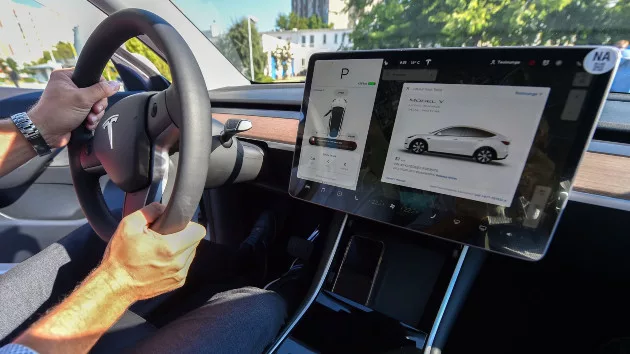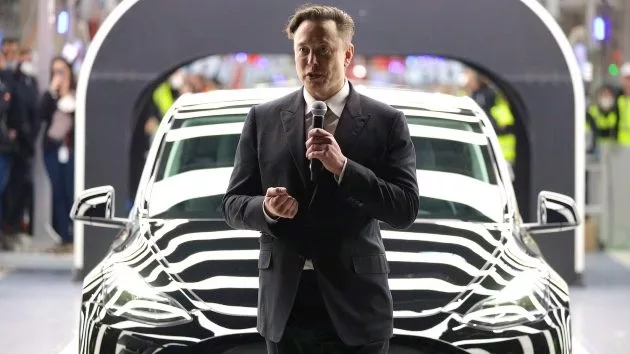
(NEW YORK) — An oft-touted advantage of owning an electric vehicle is one-pedal driving, when drivers can slow down a vehicle simply by lifting off the throttle.
But as more Americans swap their gas-powered cars and trucks for an EV, some are also realizing there are drawbacks to the one-pedal lifestyle.
“It can cause some people to get sick,” John Voelcker, a former editor of Green Car Reports and a contributing editor at Car and Driver, told ABC News. “Strong regenerative braking, which recaptures max energy, can cause motion sickness. There is a learning curve to lifting off the accelerator in an EV … you have to modulate it.”
Voelcker said he has felt queasy at least twice while riding in the back seat of a Tesla.
“The drivers didn’t know how to modulate Tesla’s strong regen braking,” he recalled. “I was thrown around a little bit.”
Ed Kim, president and chief analyst of AutoPacific, said Teslas are the “worst offenders” because they can be “very jerky and really abrupt.”
“Most automakers have tuned the throttles to be jumpy in EVs to emphasize the power, but the side effect is that they can lurch and make some occupants car sick. You have to be so careful on how to apply the throttle … if not, it can lead to an abrupt seesaw motion for passengers,” Kim told ABC News.
Kim said his wife has gotten nauseous in a Tesla Model Y and he’s heard of similar experiences from other motorists. The extremely quick acceleration of EVs can be disorienting to Americans who learned how to drive with an gasoline engine.
“EVs have so much torque — you tap the throttle and the thing just takes off. The abruptness of power delivery can be unsettling to some people. If you set really high regenerative braking, the car lurches forward and rocks and back forth a lot,” he said.
Dr. D.J. Verret, an ear, nose and throat doctor in Texas, said motion sickness in EVs “is a real thing.”
Verret pointed out that the lack of sound in an EV can also worsen the experience for passengers, especially those already prone to motion sickness.
“The brain sets up a model for what it expects in certain situations,” he told ABC News. “In combustion cars, you hear the engine revving and know someone is stepping on the accelerator. The car moves forward. In an EV, the auditory and visual inputs don’t fit the model that you are actually moving.”
Passengers are more susceptible to dizziness and nausea in an EV than drivers, especially when they’re in the back seat.
“If you’re the driver, your head moves when you turn the wheel to the left,” he said. “Our brain is responding to what it’s expecting to happen. If you’re a passenger, you can’t see those motions. If you have a certain lateral acceleration — like turning a corner fast — that will increase your potential for dizziness and motion sickness.”
Monica Jones, an associate research scientist at the University of Michigan Transportation Research Institute, has been studying motion sickness for years. It’s a topic that’s gathering “a lot of interest,” she told ABC News, adding that researchers are still not clear on why some people are more sensitive to motion sickness.
She recently completed a study with an automaker that looked at longitudinal jerk, “which is what happens with regen braking,” she said.
Jones and her team modulated the jerk in an automated vehicle while maintaining its peak acceleration. Participants were “very sensitive to the jerk,” she said.
“Motion sickness ratings increased on average throughout the duration of the trial and significant interactions were observed between levels of longitudinal jerk and time,” she said. “The highest rate of accumulation or earliest onset of motion sickness was observed for the jerk condition with the highest magnitude.”
Jones said this research could help automakers ameliorate motion sickness in EVs as they continue to refine the technology with newer models.
“One-pedal driving is a very different experience than combustion engines,” she said. “Even if you learn how to effectively do one-pedal driving, uncertainty in the environment — like traffic — can still cause motion sickness.”
There are EVs available now that ride similarly to an internal combustion engine vehicle, a bonus for those looking to avoid a Tesla-like ride. Hyundai’s new Ioniq 5 N, a chic hatch that makes 641 horsepower, comes with fake gearing and artificial engine noises, delivering a gas-powered experience on and off the track.
Matt Farah, host of the popular “The Smoking Tire” podcast, said he was so blown away by the Ioniq 5 N that his perspective on EVs has changed.
“We now know it’s possible to make an EV fun,” he told ABC News. “The synthetic gearbox and synthetic noises successfully mimic what we like about gasoline sports cars.”
Farah said he, too, has been queasy in an EV before, especially when going really fast or doing full throttle launches.
“If I do two or three launches in a row in an EV, I don’t feel great after,” he said. “The way an EV motor delivers power — and the absence of sound — are what make you feel dizzy going fast in one.”
Hyundai’s decision to include the fake gearing and noises (N e-shift and N active sound+) “were not created to alleviate queasiness or motion sickness, although it is possible that these features might indirectly help reduce some of those effects for electric vehicle drivers,” a company spokesperson told ABC News.
Either way, Farah, who test drove the Ioniq 5 N in California last month, said more automakers should follow Hyundai’s example.
“You have more control over what the car is doing with the gears. You want to control what the car is doing — that is the point of driving,” he said. “You realize the sound is fake, but after a few minutes of driving, it’s giving what you need and it works.”
The Cadillac Lyriq, a sleek electric sport utility vehicle that went into production last year, may not have fake engine noises but its tuning and drive quality has won over motorists who are anti one-pedal driving.
“It’s the closest approximation to an ICE car that I have seen in a while,” Voelcker said.
The Lyriq does not lurch forward unexpectedly like some of the other electric SUVs, Kim pointed out.
“The acceleration is more gentle,” he said. “The passenger experience is more like a traditional gas car — no matter who drives it.”
Kevin Cansiani, a senior engineer at Cadillac, told ABC News the Lyriq drives even better than an ICE car.
“My gripe with ICE transmissions are those shifts and jerks you always get,” he said. “With the Lyriq, there’s just this feeling of seamless torque. The goal of the engineers was to make the Lyriq have a premium drive quality.”
Cansiani ‘s team tuned the Lyriq so that passengers and drivers alike would not be affected by the SUV’s throttle response.
“We came up with a common set of throttle mapping and had specific drive scorecards. We took objective measurements on jerk — that sting you feel,” he said.
The Lyriq offers three regen modes — off, normal or high. Cansiani said the majority of Lyriq customers choose the normal mode for the “instant feel of negative torque.”
And driving with the regen off won’t impact range, Cansiani noted.
“You’re not losing a lot of range,” he said. “We have blended braking on the Lyriq. The brake pedal, when pressed, will command as much regen as possible. When maxed out, only then will it transition to friction braking.”
For electric car rookies, there are ways to minimize the shock when driving some EVs on the market.
“People who are newer to EVs are not accustomed to how powerful and torquey these things can be,” Kim noted, adding that it’s relatively easy to get comfortable with the tech.
He recommended that drivers set up eco mode in their EVs to make the throttle less sensitive.
“It will give you a more relaxed driving style,” he said.
His other suggestion was that engineers adjust the throttle mapping in an electric vehicle so it more closely mimics how a gasoline-powered car moves and operates.
Voelcker said regen braking is different on every EV and some vehicles may be better than others for those with a lead foot. He personally is a fan of the driving technique: “I don’t touch the brakes. The car does the braking for you.”
Worst case scenario for those who are having trouble with the EV’s stop-start manner? Shut off the regen entirely, Voelcker said.
“It’s about muscle control in the foot,” he explained. “People who drive gas cars, they don’t glide. They accelerate to the stop sign then slam on the brakes.”
He added, “A lot of motion sickness, honestly, is because of the driver.”
Copyright © 2024, ABC Audio. All rights reserved.








